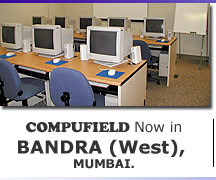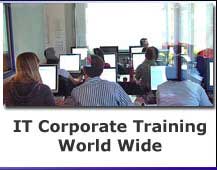|
Overview:
The
Wireless LAN Administration course, whether in an academic format
or a 5-day fast-track format, provides the networking professional
a complete foundation of knowledge for entering into or advancing
in the wireless networking industry. From basic RF theory to link
budget math, including topics from troubleshooting to performing
a site survey, this course delivers hands on training that will
benefit the novice as well as the experienced network professional.
Audience:
This
course targets both novice and experienced networking professionals
who wish to gain a solid understanding of wireless networking
to complement their knowledge of traditional wired networking.
Course
Duration:
The Wireless LAN Administration course consists of 40 hours of
material, incorporating both lecture and hands-on labs. The class
may be taught in a 5-day period.
Certification:
This course may be used - and is the ideal track - for preparing
students for the CWNA exam (exam PW0-100).
Prerequisites:
It
is recommended that all students have at least a basic knowledge
of networking (as exhibited in Net+, CCNA®, CNA, or) prior
to enrolling in the course.
Course
Outline
Radio
Frequency (RF) Fundamentals
RF
behavior and properties
Principles
of antennas
RF
math calculations
Link
budgets and system operating margins
Spread
Spectrum Technologies
Uses
of Spread Spectrum
Frequency
Hopping (FHSS)
Direct
Sequencing (DSSS)
Orthogonal
Frequency Division Multiplexing (OFDM)
Packet
Binary Convolutional Coding (PBCC)
Comparing
DSSS, FHSS, PBCC, and OFDM
Co-location
and throughput analysis
Chipping
code, processing gain, and spreading functions Channels, data
rates, ranges, and comparisons Channel
reuse in pure and mixed environments.
Hardware
Installation, Configuration, and Management
Access
points
Wireless
bridges
Wireless
workgroup bridges
Client
devices and accessories
Residential
gateways
Enterprise
gateways
Wireless
LAN switches
PoE
Switches and patch panels
VoWiFi
systems
Wireless
Routers
Troubleshooting
Wireless LANs
Multipath
Hidden
node
Near/Far
Identifying
and resolving interference problems
Maximizing
system throughput
Maximizing
co-location throughput
Range
considerations
Antennas
and Accessories
Omni-directional
Semi-directional
Highly-directional
Determining
coverage areas
Proper
mounting and safety
Performing
outdoor/indoor installations
Power
over Ethernet (802.3af and proprietary implementations)
Cables
and connector usage requirements
Amplifiers,
attenuators, lightning arrestors, and splitters
Fresnel
Zones and Free Space Path Loss
Interference,
Fading, and Multipath
Wireless
Network Management
Authentication, Authorization, and Accounting (AAA) functions
Bandwidth
control
Wireless
Network Management features and products
Physical
and MAC Layers
Differences
between wireless and Ethernet frames
Collision
handling and the use of RTS/CTS
Throughput
and dynamic rate selection
Analysis
of DCF mode and the CSMA/CA protocol
How
frame fragmentation works and its affects on throughout
Wireless
LAN Security
Analysis
of 802.11 security including WEP, WPA, 802.1x/EAP types, and 802.11i
Available
security solutions at Layer 2, 3, & 7
Types of network attacks, and protecting the network from attacks
Corporate
security policies including baseline practices and common security
solutions
Security
recommendations
Organizations
and Standards
FCC
rules
Frequency
ranges and channels
IEEE
802.11 family of standards
Wireless
LAN organizations
Proper
application of WLANs in distribution and access roles
Interoperability
standards
802.11
Network Architecture
Joining
a wireless LAN
Authentication
and association
Basic
Service Sets
Extended
Service Sets
Independent
Basic Service Sets
Distribution
systems
Roaming
in a wireless LAN
Scanning
modes using Beacons and Probe Frames
Power
management features
Site
Surveying
Understanding
the need for a site survey
Defining
business requirements and justification
Facility
analysis
Interviewing
network management and users
Identifying
bandwidth requirements
Determining
contours of RF coverage
Documenting
installation problems
Locating
interference
Reporting
methodology and procedures
Understanding
specifics of each vertical market
Understanding
the customer's network topology
Creating
appropriate documentation during and after the site survey
Understanding
FCC/FAA rules regarding towers
Understanding
safety hazards
Using
appropriate hardware and software to perform the survey
Hands-on
Lab Exercises
Lab-1:
Infrastructure Mode Connectivity
This exercise demonstrates wireless client devices connecting
to an access point. Students configure the access point, wireless
stations, and view the association table in the access point
in order to understand the process a client goes through to
become connected to the network. RF output power is explained
and client utilities are viewed to show RF signal quality and
strength. Access point features, authentication, association,
and encryption are all discussed and demonstrated. 802.11a/b/g
technologies are each shown independently to demonstrate channel
usage and spread spectrum technologies.
Lab 2: Infrastructure Mode Throughput
Analysis
This exercise demonstrates the expected throughput achievable
from a wireless station to a wired station and a wireless station
to a wireless station using FTP and throughput measuring software.
The point of this lab is for the student to understand the half-duplex
nature of wireless LANs and how the data rate relates to actual
throughput in a real-world scenario. Access point frame relay
is
proven and explained.
Lab 3: Ad Hoc Connectivity and Throughput
Analysis
In this exercise, wireless clients will connect to
each other without use of an access point. Beaconing and channel
configuration in an Ad Hoc environment will be explained and
throughput will be analyzed and compared against an infrastructure
environment. Use of SSIDs, WEP/WPA, channels, and other connectivity
factors will be
discussed and demonstrated.
Lab 4: Cell Sizing
and Automatic Rate Selection (ARS) in an Infrastructure Environment
In this exercise, RF cell sizing and ARS will be demonstrated.
Cell sizing is important for seamless connectivity while roaming
and for security purposes. ARS is the wireless LAN client's
ability to increase or decrease the data rate of the wireless
connection in order to maintain optimum connectivity with the
access point. Environmental factors will be analyzed. A basic
site survey will be performed during this lab exercise using
802.11a/b/g technologies.
Lab
5: Co-Channel and Adjacent Channel Interference
In
this exercise, the effects of co-channel and adjacent channel
interference are demonstrated and explained. Throughput tests
using FTP and throughput measurement software are performed
using fully-overlapping,partially-overlapping,andnon-overlapping
channels. Effects are analyzed and compared for DSSS and OFDM
environments.
Lab
6: Rudimentary Security Features
In
this exercise, the security features that are specified in the
IEEE 802.11 standard and the new WPA 1.0 interoperability standard
are demonstrated in a mobile environment. Wireless clients attempt
roaming between access points while using like and different
Service Set Identifiers (SSIDs), MAC filters, Wired Equivalent
Privacy (WEP) and Wi-Fi Protected Access (WPA) using Pre-shared
Keys (WPA-PSK). Configuration, use, and security issues are
discussed, explained, and demonstrated in 802.11a/b/g environments.
Lab
7: Dynamic WEP Keys and Mutual Authentication using 802.1x/EAP
and RADIUS
The
need for wireless security stronger than that which is available
in static WEP or WPA-PSK is explained. Port-based access control
with EAP authentication is also demonstrated and explained.
Cisco's proprietary Lightweight EAP is used with RADIUS for
scalability of authentication. The 802.1x/LEAP association process
is analyzed and rotating unicast and broadcast keys are explained.
User-based authentication is demonstrated and compared to MAC-based
authentication used in the 802.11 standard.
Lab
8: Wireless VPNs using PPTP tunnels and RADIUS
In
this exercise, the access point is the VPN tunnel server and
the PPTP VPN client software built into Microsoft Windows is
used to establish an encrypted VPN tunnel from the wireless
client to the access point. The access point then sends the
authentication request to a RADIUS server and a tunnel is established.
Use of the PPTP protocol with encryption in a wireless environment
is discussed and explained.
|





